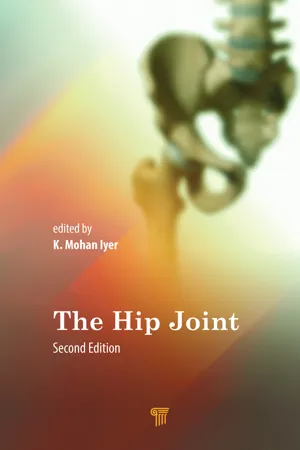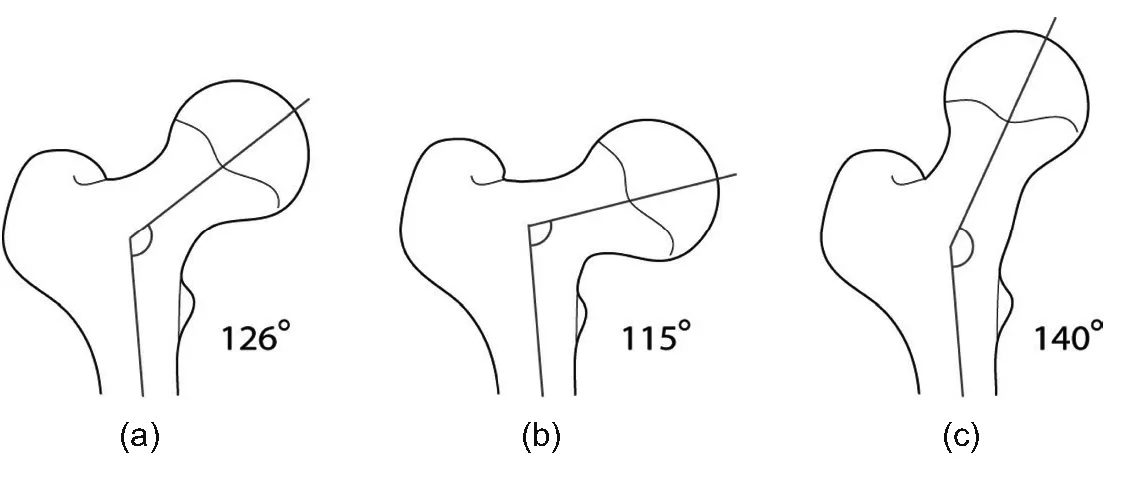
- 786 pages
- English
- ePUB (mobile friendly)
- Available on iOS & Android
The Hip Joint
About this book
The Hip Joint, written in 2016, provides a detailed account of the hip joint's anatomy and biomechanics and covers recent trends in orthopaedic surgery of the hip joint, including the latest advances in revision total hip arthroplasty (THA), computer-assisted navigation for THA, resurfacing of the hip joint and neoplastic conditions around the hip as well as indications, complications and outcomes of hip arthroscopy. Another book, The Hip Joint in Adults: Advances and Developments, gives additional important details of how hip joint surgery has evolved around the world. While much of the basic knowledge in this area is constant, it is critically important to stay current on those areas that do change.
This updated second edition of The Hip Joint contains a host of original articles from contributory authors all around the world, showing the evolution of the hip joint till the present day, building upon the solid foundation set by the first edition. It covers hot topics such as 3D printing in orthopaedics and traumatology, stem cell therapy in orthopaedics, hip resurfacing, hip-preserving surgery, sports medicine for the hip joint, robotic-assisted surgery in orthopaedics and neoplastic conditions around the hip.
Frequently asked questions
- Essential is ideal for learners and professionals who enjoy exploring a wide range of subjects. Access the Essential Library with 800,000+ trusted titles and best-sellers across business, personal growth, and the humanities. Includes unlimited reading time and Standard Read Aloud voice.
- Complete: Perfect for advanced learners and researchers needing full, unrestricted access. Unlock 1.4M+ books across hundreds of subjects, including academic and specialized titles. The Complete Plan also includes advanced features like Premium Read Aloud and Research Assistant.
Please note we cannot support devices running on iOS 13 and Android 7 or earlier. Learn more about using the app.
Information
Chapter 1
Applied Anatomy of the Hip Joint
[email protected]
1.1 The Hip Joint


- The capsule is a cylindrical sleeve which extends from the pelvis proximally to the intertrochanteric line anteriorly distally. Laterally, the acetabular labrum extends to the femoral head, while posteriorly it extends to the neck of the femur just 1 cm medial to the intertrochanteric crest. The articular labrum and the capsule are thicker antrosuperiorly, while being thinner posteroinferiorly. This capsule has circular and longitudinal fibres. The circular fibres form a collar around the neck to be called as zona orbicularis, while the longitudinal fibres travel along the neck and carry the blood vessels. At its attachment to the intertrochanteric line anteriorly, blood vessels are reflected upwards along the neck as bands called retinacula, which supply the head and neck of the femur.
- The synovial membrane lines the capsule and is attached to the margins of the articular surfaces. It ensheaths the ligament of the head of the femur and covers the pad of fat in the acetabular fossa.
- The psoas bursa is formed by a pouch of synovial membrane which protrudes through a gap in the anterior wall of the capsule between the pubofemoral and iliofemoral ligaments to form the psoas bursa beneath the psoas tendon.
1.2 Ligaments of the Hip Joint
- Intra-articular:
- The ligamentum teres
- The transverse acetabular ligament
- The acetabular labrum
- Extra-articular:
- The iliofemoral ligament (the Y ligament of Bigelow) is the strongest, inverted Y-shaped ligament, with its base attached to the anterior inferior iliac spine above and below by its two limbs to the upper and lower parts of the intertrochanteric line of the femur. This strong ligament prevents over-extension during standing.
- The pubofemoral ligament is triangular, with its base attached to the superior pubic ramus of the pubis and the apex attached to the lower part of the intertrochanteric line. This ligament limits extension and abduction.
- The ischiofemoral ligament is a spiral-shaped ligament attached to the body of the ischium near the acetabular margin. The fibres then pass upwards and laterally to the greater trochanter to blend with the zona orbicularis, and they limit extension. It tightens with internal rotation and is the more commonly injured ligament than the other ligaments.
The ligamentum teres is a round, flat, triangular ligament which is also called the round ligament. Its apex is attached to the fovea capitis and its base to the transverse ligament and margins of the acetabular notch. It functions in transmitting arteries to the head of the femur (acetabular branches of the obturator and medial circumflex femoral arteries). It tightens during adduction, flexion and external rotation and thus prevents subluxation of the femoral head superiorly and laterally in adduction and external rotation movements of the hip joint.
- The transverse acetabular ligament is formed by the acetabular labrum as it bridges the acetabular notch. It thus converts the notch into a tunnel through which the arteries and nerves pass to enter into the joint.
- The ligament of the head of the femur is flat and triangular attached by its apex to the pit on the head of the femur (fovea capitalis) and by its base to the transverse ligament and the margins of the acetabular notch. It lies within the joint and is ensheathed by the synovial membrane.
- The acetabular labrum is made up mostly of type I collagen fibres, which narrows the mouth of the acetabulam and helps in holding the head of the femur in position. It provides stability by creating negative intra-articular pressure in the hip joint, thereby improving mobility by providing an elastic alternative to the bony rim.
1.3 Movements of the Hip Joint
| Movements | Main muscles | Accessory muscles |
|---|---|---|
| Flexion | Psoas major and iliacus | Pectineus, rectus femoris, sartorius and adductor longus |
| Extension | Gluteus maximus, biceps femoris, semimembranosus and semitendinosis | Gluteus medius |
| Adduction | Adductor longus, brevis and magnus | Pectineus and gracilis |
| Abduction | Gluteus medius and minimus and tensor fasciae latae | Sartorius, piriformis |
| Medial rotation | Tensor fasciae latae and anterior fibres of the gluteus medius and minimus | Adductor longus brevis and pectineus |
| Lateral rotation | Obturator externus, internus, gamellus superior, gamelus inferior, quadratus femoris, gluteus maximus, sartorius | Piriformis, biceps femoris |
Table of contents
- Cover
- Half Title
- Title Page
- Copyright Page
- Dedication
- Table of Contents
- Foreword
- Preface
- 1. Applied Anatomy of the Hip Joint
- 2. Biomechanics of the Hip Joint
- 3. Septic Arthritis of the Hip in Children
- 4. Developmental Dysplasia of the Hip
- 5. Bearing Materials in Total Joint Arthroplasty
- 6. 3D Printing: Clinical Applications in Orthopaedics and Traumatology
- 7. Stem Cell Therapy in Orthopaedics
- 8. Principles of Anterior Approach for Total Hip Arthroplasty
- 9. Periprosthetic Fractures of the Hip Joint
- 10. Periprosthetic Osteolysis after Total Hip Replacement
- 11. Surgical Approaches to the Hip Joint
- 12. Classifications Used in Total Hip Arthroplasty
- 13. Total Hip Arhroplasty
- 14. Hip Resurfacing
- 15. Proximal Femoral Replacement
- 16. Pelvic and Acetabular Reconstruction Following Oncological Resection
- 17. Complications of Hip Arthroscopy
- 18. Femoral Neck-Lengthening Osteotomies around the Hip Joint
- 19. Hip-Preserving Surgery
- 20. Extracorporeal Shockwave Treatment of the Hip
- 21. Sports Medicine of the Hip Joint
- 22. Evaluation of a Painful Total Hip Replacement
- 23. Robotic-Assisted Surgery in Orthopaedics
- 24. Computer Navigation in Hip Arthroplasty
- 25. Surgical Advancements in Hip Arthroscopy and FAI Syndrome: Indications and Technique for Labral Reconstruction of the Hip
- 26. Fracture Neck of the Femur
- 27. Conversion of Hip Arthrodesis to Total Hip Arthroplasty
- 28. The Direct Anterior Approach to the Hip
- 29. Modified PLOP Osteotomy Approach to the Hip
- 30. Single-Incision Piriformis-Sparing Posterior THA
- 31. Imaging of the Hip Joint
- 32. Neoplastic Conditions around the Hip
- Index